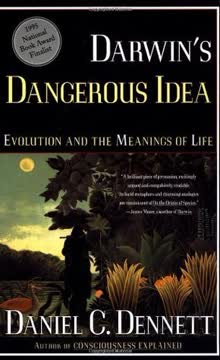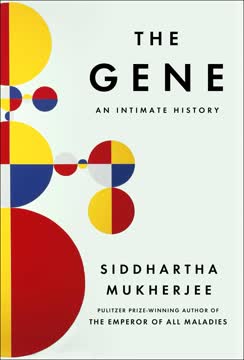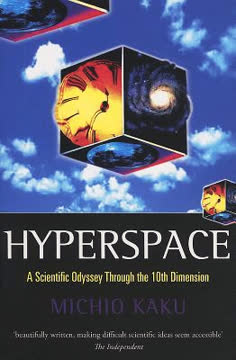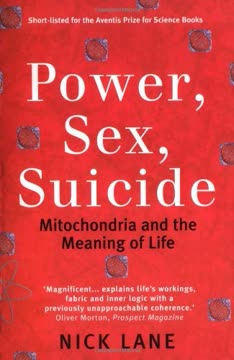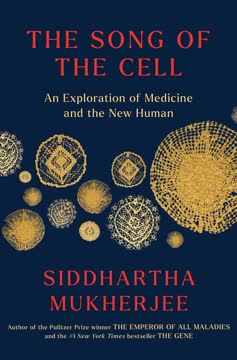اہم نکات
1. ہمارا جینوم زندگی کی ایک کتاب ہے، جو ڈیجیٹل کوڈ میں لکھی گئی ہے
انسانی جینوم ایک کتاب ہے ... اس میں تئیس ابواب ہیں، جنہیں کروموسومز کہا جاتا ہے۔ ہر باب میں کئی ہزار کہانیاں ہیں، جنہیں جینز کہا جاتا ہے۔
زندگی کی ڈیجیٹل زبان۔ جینوم بنیادی طور پر ایک معلوماتی نظام ہے، جو ڈی این اے کے چار حرفی الفاظ (A، C، G، T) میں کوڈ کیا گیا ہے۔ یہ ڈیجیٹل کوڈ انسانی وجود کی تشکیل اور عمل کے لیے ہدایات فراہم کرتا ہے۔ جینوم کی ساخت ایک کتاب کی طرح ہے:
- 23 کروموسوم ("ابواب")
- 20,000-25,000 جینز ("کہانیاں")
- 3 ارب ڈی این اے بیس پیئرز ("حروف")
کمپیوٹر کوڈ کی طرح، جینوم کو پڑھا، کاپی اور یہاں تک کہ ایڈٹ بھی کیا جا سکتا ہے۔ اس کی ڈیجیٹل نوعیت نسلوں کے درمیان جینیاتی معلومات کی درست نقل اور منتقلی کی اجازت دیتی ہے۔
2. ہم تمام جانداروں کے ساتھ ایک مشترکہ جد ancestor ہیں
مکھیاں اور انسان صرف ایک تھیم کی مختلف شکلیں ہیں کہ جسم کیسے بنایا جائے، جو کیمبرین دور میں کسی کیڑے جیسی مخلوق میں رکھی گئی تھی۔
زندگی کی یکجہتی۔ زمین پر تمام زندگی ایک مشترکہ جد ancestor کو شیئر کرتی ہے اور ایک ہی جینیاتی کوڈ استعمال کرتی ہے۔ یہ وضاحت کرتا ہے کہ:
- بہت سے جینز مختلف انواع میں محفوظ ہیں
- ہم انسانی حیاتیات کے بارے میں جاننے کے لیے پھل کی مکھیاں یا چوہے کا مطالعہ کر سکتے ہیں
- جینیاتی انجینئرنگ مختلف انواع کے درمیان جینز منتقل کر سکتی ہے
زندگی کی شکلوں میں جینیاتی میکانزم کی مماثلتیں ارتقاء اور تمام جانداروں کے ساتھ ہماری گہری وابستگی کے لیے مضبوط ثبوت فراہم کرتی ہیں۔
3. جینز صرف بیماریوں کے لیے نہیں ہیں، بلکہ ہماری پوری حیاتیات کی تشکیل کرتے ہیں
جینز بیماریوں کا سبب بننے کے لیے نہیں ہیں۔
جینز بطور ہدایات۔ اگرچہ ہم اکثر بیماری پیدا کرنے والی تبدیلیوں پر توجہ مرکوز کرتے ہیں، جینز بنیادی طور پر معمول کی حیاتیاتی فعالیتوں کے لیے ہدایات کوڈ کرتے ہیں:
- اپنے جسم کی تعمیر اور دیکھ بھال کرنا
- جسمانی عمل کو منظم کرنا
- رویے اور ذہنی خصوصیات پر اثر انداز ہونا
بیماریوں سے وابستہ جینز عام جینز کے مختلف اقسام کی نمائندگی کرتے ہیں جن کی اہم فعالیتیں ہوتی ہیں۔ ان معمول کی فعالیتوں کو سمجھنا حیاتیات اور طب کی ترقی کے لیے بہت اہم ہے۔
4. فطرت اور پرورش پیچیدہ طریقوں سے ہمارے خصائص پر اثر انداز ہوتی ہیں
یہ کہنا کہ ہم اپنے طاقتور جینز کی رحم و کرم پر ہیں، حقیقت سے بہت دور ہے، اکثر یہ ہمارے جینز ہیں جو ہمارے رحم و کرم پر ہوتے ہیں۔
جین-ماحول تعامل۔ ہمارے خصائص ہمارے جینز اور ماحول کے درمیان پیچیدہ تعاملات کے نتیجے میں پیدا ہوتے ہیں:
- جینز یہ متاثر کر سکتے ہیں کہ ہم ماحولیاتی عوامل کا کس طرح جواب دیتے ہیں
- ماحولیاتی عوامل جین کی اظہار پر اثر انداز ہو سکتے ہیں
- کچھ جینز ہماری مخصوص ماحول کی تلاش کی خواہش پر اثر انداز ہوتے ہیں
یہ تعامل اس بات کی وضاحت کرتا ہے کہ نہ تو جینز اور نہ ہی ماحول اکیلے ہماری تقدیر کا تعین کرتے ہیں۔ ان تعاملات کو سمجھنا انسانی حیاتیات اور رویے کی پیچیدگیوں کو سمجھنے کے لیے کلیدی حیثیت رکھتا ہے۔
5. انسانی جینوم میں ہماری ارتقائی ماضی کے آثار موجود ہیں
ہم ڈیجیٹل زنجیر کے خطوط اور مارملیڈ کے بارے میں انتباہات سے بھرے ہوئے ہیں۔
جینیاتی فوسلز۔ ہمارا جینوم ایک تاریخی دستاویز ہے، جس میں شامل ہیں:
- قدیم وائرس کے آثار
- نقل شدہ جینز
- "خودغرض" ڈی این اے عناصر جو خود کو نقل کرتے ہیں
یہ جینیاتی فوسلز ہماری ارتقائی تاریخ اور جینومز کی متحرک نوعیت کے بارے میں بصیرت فراہم کرتے ہیں۔ یہ یہ بھی اجاگر کرتے ہیں کہ تمام ڈی این اے کا موجودہ عملی مقصد نہیں ہوتا۔
6. جینیاتی علم امید اور اخلاقی چیلنجز دونوں لاتا ہے
یہ کوئی حیرت کی بات نہیں کہ امریکہ میں صحت کی انشورنس کمپنیاں پہلے ہی الزائمر کے جینیاتی ٹیسٹ میں دلچسپی ظاہر کر رہی ہیں، جو ان کے لیے بہت مہنگی بیماری ہو سکتی ہے۔
دو دھاری تلوار۔ جینیاتی علم میں ترقی طب کے لیے بڑی ممکنات فراہم کرتی ہے لیکن اس کے ساتھ ہی اخلاقی خدشات بھی اٹھاتی ہے:
- ذاتی نوعیت کی طب اور بیماری کی روک تھام کی ممکنات
- انشورنس یا ملازمت میں جینیاتی امتیاز کا خطرہ
- تولیدی انتخاب اور جینیاتی انجینئرنگ میں اخلاقی مسائل
جینیاتی علم کے فوائد کو اخلاقی غور و فکر کے ساتھ متوازن کرنا معاشرے کے لیے ایک اہم چیلنج ہے۔
7. آزاد مرضی ہمارے جینیاتی تعین پسندی کی حدود میں موجود ہے
آزادی آپ کی اپنی تعین پسندی کے اظہار میں ہے، نہ کہ کسی اور کی۔
تعین پسندی اور آزاد مرضی کا مصالحت۔ اگرچہ ہمارے جینز ہمارے خصائص اور رجحانات پر اثر انداز ہوتے ہیں، وہ ہمارے انتخاب کو سختی سے متعین نہیں کرتے:
- جینز رجحانات پیدا کرتے ہیں، نہ کہ مقررہ مقدر
- ہمارے شعوری فیصلے جینیاتی اثرات کو ختم کر سکتے ہیں
- اپنے جینیاتی رجحانات کو سمجھنا ہمیں باخبر فیصلے کرنے کے قابل بناتا ہے
یہ نقطہ نظر ہمیں جینیاتی اثرات کی حقیقت اور ذاتی ذمہ داری اور انتخاب کی اہمیت دونوں کو قبول کرنے کی اجازت دیتا ہے۔
آخری تازہ کاری:
FAQ
What's Genome: The Autobiography of a Species in 23 Chapters about?
- Exploration of the genome: The book delves into the human genome, explaining how genes influence various aspects of human biology and behavior.
- Chromosome-by-chromosome narrative: Matt Ridley examines each chromosome, linking them to themes of human nature and history, providing a comprehensive view of genetics.
- Interdisciplinary insights: It combines genetics, anthropology, psychology, and philosophy to show how our genetic makeup shapes who we are.
Why should I read Genome: The Autobiography of a Species in 23 Chapters?
- Understanding genetics' impact: The book helps readers grasp how genetics influences health, behavior, and identity, essential for understanding ourselves.
- Engaging storytelling: Ridley’s narrative style makes complex scientific concepts accessible and engaging, using anecdotes and historical context.
- Timely relevance: It addresses contemporary issues in genetics, such as genetic engineering and ethical implications, making it a thought-provoking read.
What are the key takeaways of Genome: The Autobiography of a Species in 23 Chapters?
- Genes shape our lives: Genes play a crucial role in determining health, personality, and behavior, illustrated through examples from different chromosomes.
- Complexity of inheritance: Traits are influenced by multiple genes and environmental factors, challenging simplistic notions of genetic determinism.
- Interconnectedness of life: The book underscores that all life is interconnected through shared genetic codes, emphasizing common ancestry.
What are the best quotes from Genome: The Autobiography of a Species in 23 Chapters and what do they mean?
- “We are living through the greatest intellectual moment in history.”: Reflects the transformative power of genetic knowledge, revolutionizing fields like medicine.
- “The genome is a book that wrote itself.”: Illustrates the dynamic nature of the genome, evolving over time through mutations and natural selection.
- “Life consists of the interplay of two kinds of chemicals: proteins and DNA.”: Highlights the fundamental relationship between genes and proteins in biological processes.
How does Genome: The Autobiography of a Species in 23 Chapters explain the relationship between genes and diseases?
- Genes as disease contributors: Certain genes can predispose individuals to specific diseases, crucial for developing effective treatments.
- Complexity of genetic diseases: Many diseases are influenced by multiple genes and environmental factors, requiring a nuanced understanding.
- Role of genetic research: Continued research into the human genome is advocated to uncover the genetic basis of diseases for better prevention and treatment.
What is the significance of chromosome 2 in Genome: The Autobiography of a Species in 23 Chapters?
- Fusion of ape chromosomes: Chromosome 2 is formed from the fusion of two ape chromosomes, highlighting evolutionary relationships.
- Implications for human evolution: This fusion suggests a significant evolutionary event contributing to modern human development.
- Understanding human uniqueness: Examining chromosome 2 explores genetic traits distinguishing humans from other primates.
How does Genome: The Autobiography of a Species in 23 Chapters address the concept of free will?
- Genetic influence on behavior: Genes can shape behaviors and personality traits, raising questions about the extent of free will.
- Interplay of nature and nurture: Both genetic and environmental factors shape behavior, essential for understanding free will.
- Philosophical implications: Genetic knowledge can inform our understanding of human agency, leading to greater self-awareness.
What role do environmental factors play in Genome: The Autobiography of a Species in 23 Chapters?
- Interaction with genetics: Environmental factors interact with genetic predispositions to shape traits and health outcomes.
- Examples of environmental influence: Lifestyle choices can impact gene expression and health, highlighting the importance of both genetics and environment.
- Dynamic nature of the genome: The genome can be influenced by environmental factors throughout life, underscoring genetic inheritance complexity.
How does Genome: The Autobiography of a Species in 23 Chapters explain the concept of eugenics?
- Historical context: The history of eugenics and its association with genetic determinism is discussed, highlighting dangers of misapplying genetic knowledge.
- Modern implications: Warns against potential misuse of genetic information, advocating for ethical considerations in genetic research.
- Call for responsible science: Emphasizes the need for responsible scientific inquiry that respects individual rights and diversity.
What insights does Genome: The Autobiography of a Species in 23 Chapters provide about human history?
- Genetic record of migration: The human genome contains clues about ancestors’ migrations and adaptations, revealing patterns of human history.
- Connection to ancient diseases: Historical diseases have shaped genetic makeup, influencing traits like resistance to infections.
- Interconnectedness of all life: The genome serves as a record of shared ancestry, fostering appreciation for biodiversity and conservation.
What is the significance of Hox genes in Genome: The Autobiography of a Species in 23 Chapters?
- Role in body plan: Hox genes determine the layout of an organism's body during embryonic development.
- Conservation across species: Remarkably similar in different species, indicating a common evolutionary ancestor.
- Implications for understanding evolution: Provides insights into how complex body structures evolved, revealing genetic diversity basis.
How does Genome: The Autobiography of a Species in 23 Chapters relate to the future of genetic research?
- Promise of personalized medicine: Genetic research could lead to personalized medical treatments tailored to individual genetic profiles.
- Ethical considerations: Raises important ethical questions about genetic engineering and implications of manipulating the human genome.
- Ongoing discoveries: The field of genetics is rapidly evolving, with new discoveries continually reshaping our understanding of biology.
جائزے
جینوم: ایک نوع کی خودنوشت 23 ابواب میں کو اس کی سادہ وضاحت اور دلچسپ تحریر کے لیے زیادہ تر مثبت تبصرے ملے۔ قارئین نے ریڈلی کے اس انداز کو سراہا کہ انہوں نے ہر کروموسوم کا استعمال کرتے ہوئے انسانی حیاتیات اور معاشرت کے مختلف پہلوؤں کی کھوج کی۔ کچھ لوگوں نے اس کے بعض حصوں کو پرانا قرار دیا یا ریڈلی کی ذاتی آراء پر تنقید کی، لیکن بہت سے لوگوں نے اسے جینیات کے بارے میں معلوماتی تعارف کے طور پر تجویز کیا۔ اس کتاب میں ذہانت اور یوجینکس جیسے متنازعہ موضوعات کی کھوج نے قارئین کے درمیان بحث و مباحثہ کو جنم دیا۔
Similar Books




